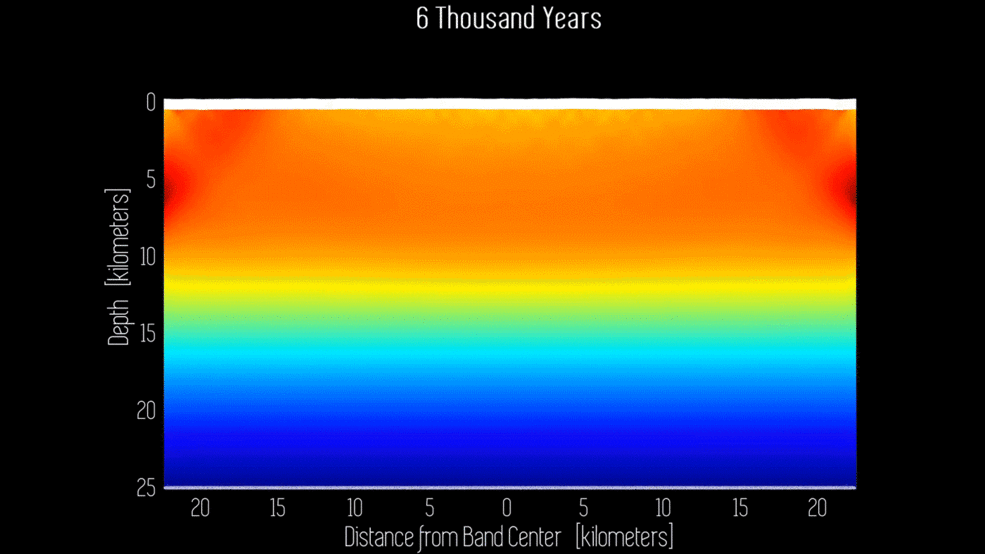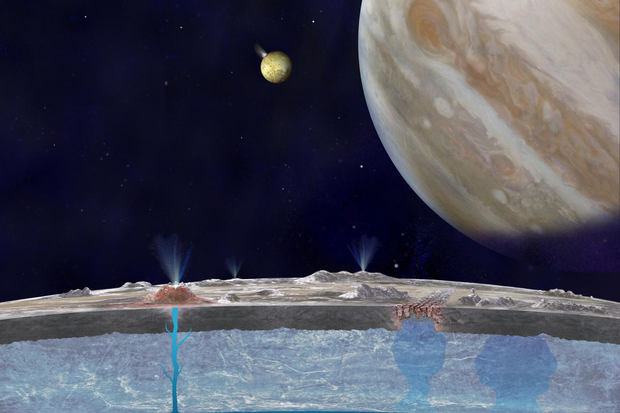Europa’s Buried Ocean Could Rise to the Surface (Video)

Beneath the icy surface of Jupiter's moon Europa lies a massive liquid ocean — and one new animation shows how this subsurface water could move to the moon's surface.
Europa's ice shell is changed by gravitational interactions with Jupiter, according to a statement. The new animation is one of a number of simulations that show behaviors on Europa from a new study, published May 2018 in the journal Geophysical Research Letters, conducted by scientists from NASA's Jet Propulsion Laboratory in Pasadena, California.
As gravity pulls at Europa's icy shell, faults form and re-form in the ice — these faults can be seen in the animation as yellow, green and blue lines. The lighter, speckled, swirling bottom of the animation represents the upper part of Europa's ocean that meets the ice. The little white dots represent pieces of the ocean that have been frozen into the bottom of the ice. [Europa Report: Jupiter's Icy Moon Explained (Infographic)]

The researchers who made this animation refer to these little white bits as "fossil" ocean material because the pieces spend hundreds of thousands or even millions of years traveling to the moon's surface. Bits that reach the surface could be from over a million years prior, so spacecraft that study these "fossils" would reveal a picture of Europa's ancient ocean.
NASA has plans to further study the moon and will send the Europa Clipper spacecraft to Europa in the early 2020s. This craft will be the first spacecraft intended to study Europa exclusively. The craft will analyze the moon's surface during a series of flybys, looking to figure out what it's made of, and it will likely be able to test and validate this animated simulation, according to the statement.
While Europa's "fossil" ocean material won't show the current state of the moon's ocean, the spacecraft will also analyze these bits. Studying these ocean bits and what they're made of could give researchers clues as to whether life could have ever existed on Europa, according to the statement.
Email Chelsea Gohd at cgohd@space.com or follow her @chelsea_gohd. Follow us @Spacedotcom, Facebook and Google+. Original article on Space.com.
Get the Space.com Newsletter
Breaking space news, the latest updates on rocket launches, skywatching events and more!
Join our Space Forums to keep talking space on the latest missions, night sky and more! And if you have a news tip, correction or comment, let us know at: community@space.com.

Chelsea “Foxanne” Gohd joined Space.com in 2018 and is now a Senior Writer, writing about everything from climate change to planetary science and human spaceflight in both articles and on-camera in videos. With a degree in Public Health and biological sciences, Chelsea has written and worked for institutions including the American Museum of Natural History, Scientific American, Discover Magazine Blog, Astronomy Magazine and Live Science. When not writing, editing or filming something space-y, Chelsea "Foxanne" Gohd is writing music and performing as Foxanne, even launching a song to space in 2021 with Inspiration4. You can follow her on Twitter @chelsea_gohd and @foxannemusic.










